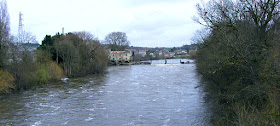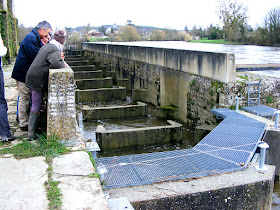The weir at Descartes is situated on the Creuse 260 kilometres from the Loire Estuary. The device to measure the flow there was installed in 2007. Since the removal of the weir at Maisons Rouges in 1999, this is the first barrier on the Creuse up river from the sea.
The weir, photographed from the bridge downstream. The papermill is on the left.
Following the observation that fish were now blocked at Descartes after the removal of the downstream weir, it was decided to build a new fish ladder (Fr. passe à poissons).
It is installed in the old navigation lock on the right bank, next to the papermill. It is a pass with successive basins with double vertical slots of the "surface jet" type. Consisting of eleven basins, it breaks down the 3.20 metre fall into eleven 30 centimetre falls. The height of fall downstream between the last basin and the Creuse is regulated by a spillway valve controlled at the downstream level of the watercourse to ensure the pass remains useable by the fish.
Fabrice, Pierre and Jane contemplate the fish ladder.
Located in the centre of the dam, an eel ramp was built into the old fish pass. It is an inclined ramp covered with an "evergreen" bottom substrate that is suitable for eel creep behaviour. Since this fishway is not equipped with a monitoring device, the eel count at Descartes is not representative of the migrating population.
Pierre and Dominique contemplate the structure.
The migration monitoring station is located at the upstream end of the fishway. It is equipped with a double fish passage recording device to count the fish going through in each set of slots. The count and some pictures of fish passing through can be seen on the LOGRAMI website.
Last year 39 salmon (Fr. saumons) were recorded, 169 shad (Fr. aloses), and 47 sea lampreys (Fr. lamproies marines). It was rather a low count because of the dry. This year, already, there have been 10 salmon, 42 shad and 14 lampreys. The bumper year for salmon and lampreys was 2015, with 204 and 23 740 respectively. Shad had a good year in 2018 with 869 passing through the fish ladder. Not all the eels use the ramp either. A few use the fish ladder to go upstream. So far 8 this year, and 8 in total last year. Barbel, bream, chub and roach also use the fish pass but are not counted.
The eel ramp in the middle.
Thanks to David Henderson for sending me details of the fish ladder, including the link to LOGRAMI.
Note that the outing to the fish ladder took place on Monday 9 March, before the current Covid19 lockdown. Our walking groups are not meeting during the lockdown.
************************************************
Covid19 Update: We've had a week of lockdown. The weekend was sad and scary and full of mostly bad news. Yesterday by contrast seemed more peaceful and calm. Two things are really striking if you do venture out into the street. First, there is even less traffic than normal and it is very quiet. Everyone is commenting on how much wildlife they can suddenly hear. The second thing, and the thing which actually makes it weird, is that no one is stopping to chat in the street or at the shops. Even when you encounter someone you know it's all a bit sombre and as if there is nothing of any consequence to say. So people greet each other awkwardly then go about their business.
I went to the farm shop on the edge of town yesterday and I'm pleased to report that neither I, nor Dottie, who was working there, have Covid19. The new seasons strawberries are in and they smelled delicious, we agreed. But they were €5 a punnet, so I declined them. I also went to the pharmacy and got my prescriptions refilled. Betablockers no problem, but I was only given a month's supply of statins. There doesn't appear to be a shortage of paracetamol and I bought a couple of boxes. My favourite hand cream though has run out. Looks like it's lots of people's favourite, and with the amount of hand washing and hand sanitizer we are all using, a good hand cream to follow up is essential.
****************************************************
For details of our private guided tours of chateaux, gardens, wineries, markets and more please visit the Loire Valley Time Travel website. We would be delighted to design a tour for you.
We are also on Instagram, so check us out to see a regularly updated selection of our very best photos.
We are also on Instagram, so check us out to see a regularly updated selection of our very best photos.





19 comments:
" I'm pleased to report that neither I, nor Dottie, who was working there, have Covid19"
How do you know?
Because we could both smell the strawberries. Loss of sense of smell is one of the early warning signs.
Very interesting and informative post, as usual!
I've read somewhere about loss of smell, but it didn't really register. Now, I'll know. Our beloved leader is quite incoherent as are his policies : give money to the rich. Who cares about a Chinese virus? Hope to stay alive long enough to vote him out of office. Praise the FSM!
Well, that's me buggered then.... no sense of smell at the best of times...and we are now in my allergy season... birch pollen, and to a lesser extent, rape!!
So, fairly blocked nose and itchy eyes whenever I go outside....
On other matters... today's post is a wondrous one.... very nice reading...
23,740 lamphreys... a surfeit indeed!
Actually, probably OK.... went upstairs to change out of my "detente" clothes and do a bit of gardening... itchy pollen throat made me suck a "miner's pastille".... coal tar and menthol cleared my sinuses.... caught a wiff of my armpits!
Probably too much info, sorry!!
I'm a ball of allergy right now too. and I forgot to pick up Humex nasal spray yesterday at the pharmacy dammit.
I hope you stay alive long enough to see him out too. What's the FSM?
I know! I was amazed by the numbers.
According to the Biotope "Identifier les Animaux" the larvae [that's what it says... fry presumably] spend 4 to 6 years in the sediment before returning to the sea where the spend 1.5 to 2.5 years parisitising fish... so there may be another flush in 2 years time'ish
May I suggest you ask Wikipedia about the Flying Spaghetti Monster for information and entertainment?
Right...
Gosh! I didn't realise they had a freshwater part of their life cycle (only guessed when I saw they were one of the species monitored.)
Thanks for the deets on the fish ladder. And an eel ramp, too, cool. I always know when it comes from you it’s well thought out and accurate info.
Thanks. All cribbed straight off the LOGRAMI site!
Yes, there are three species.... the big one, the Marine Lamphrey [Petromyzon marinus] 80 to 120cm long... presume they must be the 6yr/2.5yr life cycle...
the River Lamphrey [Lampetra fluviatilis] 35 to 50cm long [4yr/1.5yr? life cycle]....
and the Brook Lamphrey which has no sea cycle... spending its time in the upper reaches.... and I think is the one in the Remillion. Larval phase 5 to 9 yrs... adult for less than 6 months.
You ought to do a post!
Maybe. My problem is lack of eel photos and any real knowledge of eels. Why don't you write a post!
I have no suitable pictures.... certainly no lamphrey pictures... and lamphreys ain't eels....
Lamphreys don't have jaws... their mouth is a sucker that fixes them in place and then, they rasp and swallow.... rasp and swallow!
I've only ever seen a lamphrey on the telly. I have seen eels though -- monster ones, in Australia.
Post a Comment